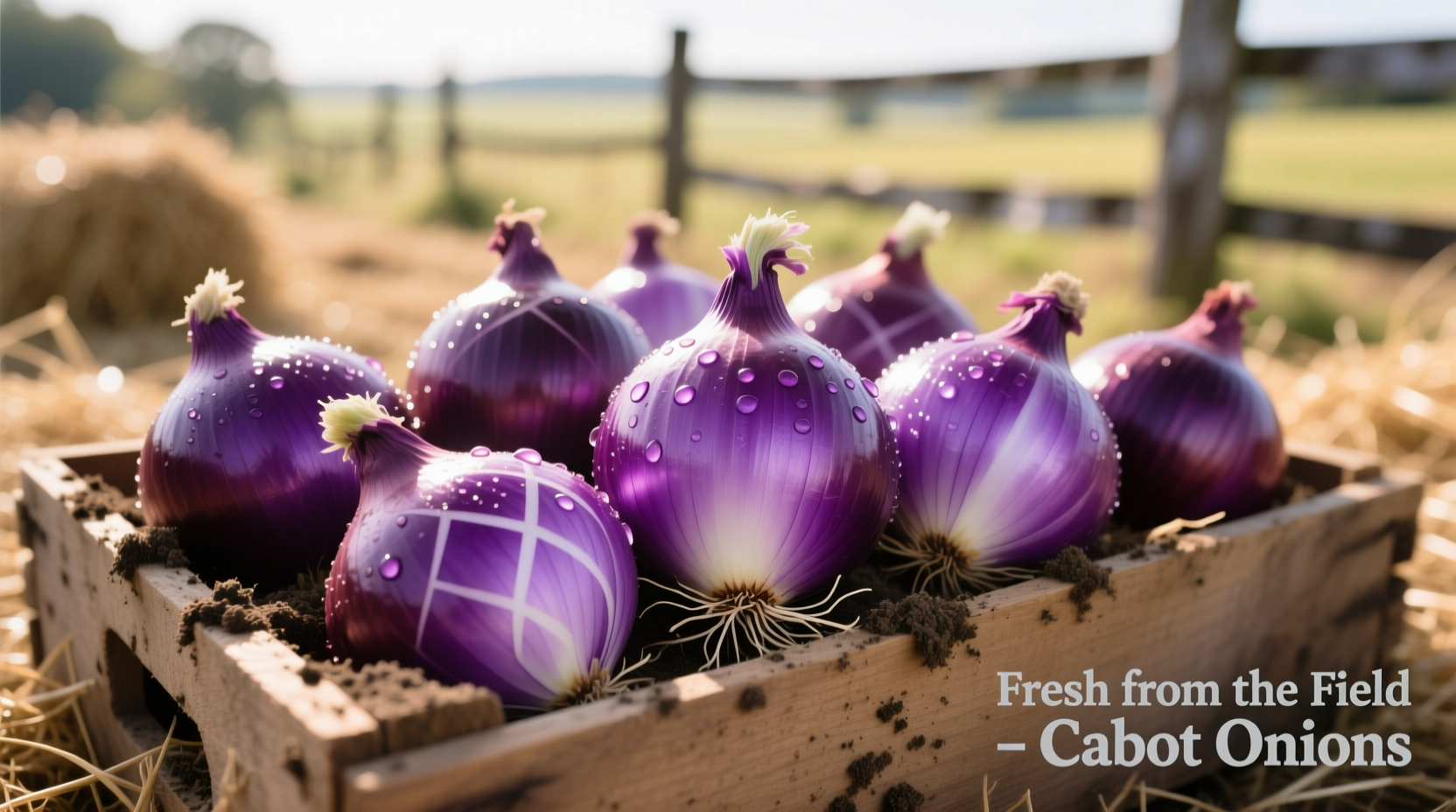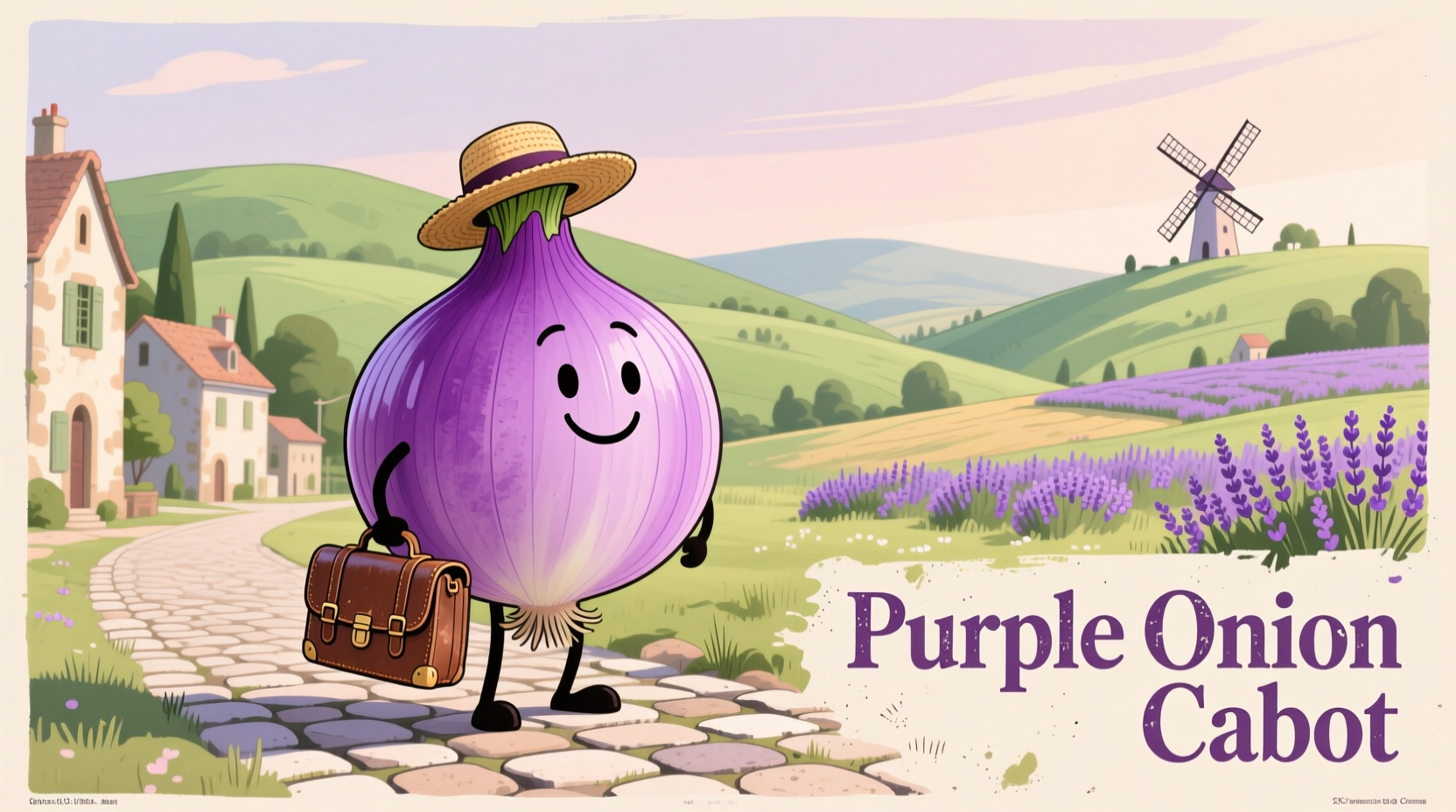When you encounter purple onion cabot in a recipe or at your local market, you're working with a specialty onion variety that delivers exceptional culinary performance. This heirloom cultivar stands apart from common supermarket purple onions through its unique growing requirements, flavor development, and versatility in the kitchen.
What Exactly Is Cabot Purple Onion?
Cabot purple onion (Allium cepa 'Cabot') is a long-day storage onion variety developed specifically for northeastern US climates but now cultivated across North America. Unlike generic purple onions you find year-round, Cabot is a seasonal heirloom with a defined harvest window from late summer through early fall. Its distinctive characteristics include:
- Skin color: Deep violet-purple with copper undertones
- Flesh appearance: White with vibrant purple concentric rings
- Flavor profile: Initial sharpness mellowing to natural sweetness when cooked
- Size range: Typically 2.5-3.5 inches in diameter
- Storage life: 4-6 months under proper conditions

How Cabot Purple Onions Differ From Standard Varieties
Understanding the distinction between Cabot purple onions and common purple varieties is crucial for optimal culinary results. The following comparison highlights key differences that affect both flavor and application:
| Characteristic | Cabot Purple Onion | Standard Purple Onion |
|---|---|---|
| Seasonality | Late summer to early fall harvest | Available year-round (often imported) |
| Flavor Complexity | Balanced sweet-sharp with wine-like notes | Predominantly sharp with less sweetness |
| Storage Capability | 4-6 months in proper conditions | 2-3 months maximum |
| Culinary Transformation | Develops rich caramel notes when cooked | Can become bitter when cooked |
| Soil Requirements | Requires specific northeastern US soil composition | Grown in varied climates worldwide |
Optimal Culinary Applications for Cabot Purple Onions
The unique flavor profile of purple onion cabot makes it exceptionally versatile across cooking methods. Unlike standard purple onions that often lose their distinctive qualities when heated, Cabot maintains its character through various preparations:
Raw Applications
When sliced thin for salads or garnishes, Cabot purple onions deliver a crisp texture with less eye-watering sharpness than standard varieties. Their vibrant color holds up remarkably well in fresh preparations without bleeding excessively into surrounding ingredients. Try them in:
- Heirloom tomato salads with basil and olive oil
- Fresh salsas where color contrast matters
- Pickled preparations that maintain visual appeal
Cooked Applications
The real magic happens when you cook Cabot purple onions. Their natural sugars caramelize beautifully without turning bitter—a common issue with standard purple onions. Professional chefs particularly value them for:
- Caramelized onion tarts and quiches
- Onion confit for meat dishes
- Roasted vegetable medleys
- Onion jam for cheese boards
Where to Find and How to Select Cabot Purple Onions
Finding authentic Cabot purple onions requires knowing when and where to look. Unlike generic purple onions available year-round, Cabot has a specific harvest season and regional availability:
- Peak season: August through October in North America
- Best sources: Farmers markets in northeastern US states, specialty grocers, and CSAs
- Selection criteria: Firm bulbs with dry, papery skin and no soft spots
- Avoid: Sprouting bulbs or those with damp, moldy patches
According to the USDA Agricultural Marketing Service, premium quality onions should have "uniform color, freedom from damage, and proper dryness of outer skin." Cabot purple onions meeting these standards will deliver optimal flavor and storage performance.
Proper Storage Techniques for Maximum Shelf Life
One of Cabot purple onion's significant advantages over standard purple varieties is its superior storage capability. When stored correctly, they maintain quality for 4-6 months. Follow these evidence-based storage recommendations from USDA FoodData Central:
- Store in a cool, dark place with temperatures between 45-55°F (7-13°C)
- Maintain humidity around 65-70% to prevent drying
- Use mesh bags or baskets that allow air circulation
- Never store near potatoes, which emit ethylene gas that accelerates spoilage
- Do not refrigerate whole bulbs (causes texture deterioration)
Nutritional Benefits and Flavor Chemistry
Cabot purple onions deliver more than just exceptional flavor—they offer notable nutritional advantages. Like all purple onions, they contain anthocyanins (the pigments responsible for their color), which function as powerful antioxidants. According to research published in the Journal of Agricultural and Food Chemistry, purple onions contain up to 25% more anthocyanins than red cabbage.
The specific growing conditions for purple onion cabot enhance its quercetin content—a flavonoid associated with cardiovascular health. Unlike standard purple onions that vary significantly in nutrient density based on growing conditions, Cabot's regional adaptation produces consistent phytochemical profiles.
Common Misconceptions About Purple Onions
Many home cooks operate under incorrect assumptions about purple onions that can lead to disappointing results. Understanding these distinctions will help you maximize your purple onion cabot experience:
- Misconception: All purple onions are interchangeable
- Reality: Cabot has a distinct flavor profile and storage capability compared to generic purple onions
- Misconception: Purple onions shouldn't be cooked
- Reality: Cabot purple onions actually improve when properly caramelized
- Misconception: The color indicates higher spiciness
- Reality: Color relates to anthocyanin content, not pungency level
Practical Tips for Working With Cabot Purple Onions
Professional chefs employ specific techniques to maximize the potential of this specialty onion variety:
- For minimal tear production: Chill onions for 30 minutes before slicing
- For vibrant color retention: Add a splash of vinegar when pickling or cooking
- For enhanced sweetness: Slice against the grain rather than with it
- For optimal caramelization: Cook slowly over medium-low heat for 30-40 minutes
Remember that the distinctive flavor compounds in purple onion cabot develop fully about 15 minutes after cutting, so allow sliced onions to rest before using in raw applications for best results.











 浙公网安备
33010002000092号
浙公网安备
33010002000092号 浙B2-20120091-4
浙B2-20120091-4